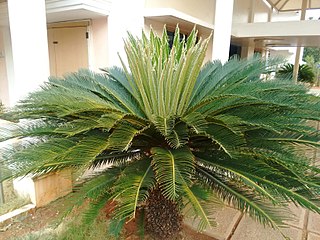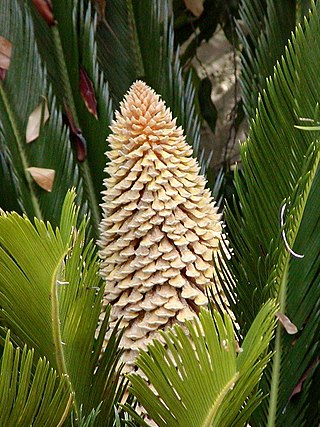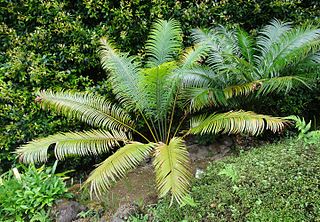Cycas pruinosa is a small to medium species of cycad, a palm-like seed plant. It is a widespread but sporadic species in the eastern and southern Kimberley region of Western Australia, occurring also in the Spirit Hills on Bullo River Station in the Northern Territory.

Cycas is a genus of cycad, and the only genus in the family Cycadaceae. About 113 species are accepted, which are native to the Indo-Pacific, East Africa and Madagascar. Cycas circinalis, a species endemic to India, was the first cycad species to be described in western literature, and is the type species of the genus. The best-known Cycas species is Cycas revoluta.

Cycas revoluta is a species of gymnosperm in the family Cycadaceae, native to southern Japan including the Ryukyu Islands. It is one of several species used for the production of sago, as well as an ornamental plant. The sago cycad can be distinguished by a thick coat of fibers on its trunk. The sago cycad is sometimes mistakenly thought to be a palm, although the only similarity between the two is that they look similar and both produce seeds.

Cycas angulata is a species of cycad in the genus Cycas, native to Australia in northeast Northern Territory and northwest Queensland.
Cycas basaltica is a species of cycad in the genus Cycas, native to Australia, in the far north of Western Australia in the Kimberley region.

Cycas bougainvilleana is a species of cycad in the genus Cycas, native to the islands northeast of Papua New Guinea, on New Britain, the Bismarck Archipelago and the Solomon Islands, where it occurs on or near the coast in calcareous coral sand dunes and in adjacent forests.
Cycas brachycantha is a species of cycad in the genus Cycas, native to northern Vietnam where it is endemic to Bắc Kạn Province. It grows in often soil-free cracks and crevices of limestone crests and ridges under the canopy of evergreen forests. It is found in Ba Bể National Park.
Cycas chamaoensis is named after the only known habitat of this species, on and near Khao Chamao mountain in Khao Chamao District, Thailand. Stems are arborescent, either erect or decumbent. Leaves numerous, exceeding 60 per crown, 1.2-2.5 meters in length, ending in terminal spine. Petiole 30–60 cm, glabrous and partially spiny. Leaflets in 85-155 pairs, and lanceolate, glabrous and angled forward at 60-70 degrees.

Cycas circinalis, also known as the queen sago, is a species of cycad known in the wild only from southern India. Cycas circinalis is the only gymnosperm species found among native Sri Lankan flora.

Cycas micronesica is a species of cycad found on the island of Yap in Micronesia, the Marianas islands of Guam and Rota, and The Republic of Palau. It is commonly known as federico nut or fadang in Chamorro. The species, previously lumped with Cycas rumphii and Cycas circinalis, was described in 1994 by Ken Hill. Paleoecological studies have determined that C. micronesica has been present on the island of Guam for about 9,000 years. It is linked with Lytico-Bodig disease, a condition similar to amyotrophic lateral sclerosis (ALS), due to the neurotoxin BMAA found in its seeds, which were a traditional food source on Guam until the 1960s. The neurotoxin is present due to its symbiosis with cyanobacteria.

Vitis sinocinerea, commonly known as the lobular grape or small-leaved grape, is a species of climbing vine in the grape family ranging widely over much of the Chinese mainland as well as Taiwan. In Chinese it is known as xiao ye pu tao, which can be translated as small-leaved grape. Its natural habitat is within forested or shrubby hills.

Cycas pectinata was the fourth species of Cycas to be named; it was described in 1826 by Scottish surgeon and botanist Francis Buchanan-Hamilton from Kamrup, Assam in northeast India. The species is one of the most widespread cycads. It is found in the northeastern part of India, Nepal, Bhutan, northern Burma, southern China (Yunnan), Bangladesh, Burma, Malaysia, Cambodia, northern Thailand, Laos, and Vietnam. Cycas pectinata usually grow at elevation 300 m to 1200 m and in difficult terrains. In China, it grows in dry, open thickets in limestone mountains, red soil in sparse monsoon forests. Cycas pectinata grows up to 40 feet (12 m) tall and has very large, ovoid male cones. The tallest Cycas pectinata is a female plant in North Kamrup, Assam which measures 52.8 feet (16.1 m). The tree is the world's tallest Cycas plant. In Northeast India, the species is under severe threat due to clearing of forest and overcollection of male cones for preparation of traditional medicines. The species is listed in CITES Appendix II and IUCN Redlist.

Cycas rumphii, commonly known as queen sago or the queen sago palm, is a dioecious gymnosperm, a species of cycad in the genus Cycas native to Indonesia, New Guinea and Christmas Island. Although palm-like in appearance, it is not a palm.
Cycas ferruginea is a plant species native to Vietnam and to the Guangxi region of China. It grows on rocky crevices in forested areas at elevations of 200–500 m. It is known from a belt of limestone bluffs in Lang Son Province and Thai Nguyen Province in Vietnam, and in western Guangxi Province, China. It is also cultivated at the Guilin Botanical Garden, Guangxi.

Cycas diannanensis is a species of cycad endemic to Yunnan, China.
Cycas pranburiensis is a species of cycad endemic to Thailand. It is found only in the Khao Sam Roi Yot National Park area of Prachuap Khiri Khan Province. It is named after Pran Buri District in Thailand, where it was discovered.

Cycas guizhouensis is a species of cycad endemic to southwestern China.

Cycas maconochiei is a species of cycad, endemic to Australia's Northern Territory. This species has three subspecies C. maconochiei ssp. maconochiei, C. maconochieissp. lanata and C. maconochiei ssp. viridis.
Cycas macrocarpa is a species of cycad in Malaysia and Thailand.

Cycas wadei is a species of cycad endemic to Culion island, Philippines. There is only one subpopulation of about 5,000 mature individuals, located in a small area to the east of Halsey Harbor.














